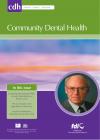Community Dental Health

- Cover Date:
- March 2009
- Print ISSN:
- 0265 539X
- Vol:
- 26
- Issue:
- 1
Childhood growth and dental caries
Objectives: The aim of the study was to examine whether the removal of carious teeth affected children’s growth relative to that of a standard population. Design: Longitudinal prospective observational study. Setting: Manchester Dental Hospital (MDH), UK. Participants: Five and six year- old children who attended for extraction of carious teeth under general anaesthesia. Main outcome measure: Change in height, weight and BMI standard deviation scores during the six months after extraction of carious teeth. Methods and materials: The children’s dental caries levels, weight and height were measured prior to extraction using standard criteria and a single trained examiner and they were then re-measured six months later. The body mass index of the children was calculated and all measurements were converted to standard deviation scores (SDS) using the UK 1990 growth reference. Changes in growth SDS during the six months subsequent to the extractions were then calculated. Results: Two hundred and eighteen children, mean (range) age 5.9 (5-6) were examined initially, of whom 131 were successfully followed up a mean 7.1 (0.13) months later. The participants had a mean dmft of 7.18 (SD 3.27) at baseline and were not shorter than expected (8.3% <10th percentile), or more underweight (6.9% <10th percentile for weight). At follow up children showed a statistically significant gain in BMI SDS (mean (SD) 0.26 (37) p<0.001) and a small gain in height SDS (0.05 (0.38) p=0.05). Conclusion: This study suggests that the extraction of carious teeth in five and six year old children promotes weight gain and possibly growth.
Key Words: childhood, dental caries, growth.
- Article Price
- £15.00
- Institution Article Price
- £
- Page Start
- 38
- Page End
- 42
- Authors
- T. Malek Mohammadi, C. M. Wright, E. J. Kay
Articles from this issue
- Title
- Pg. Start
- Pg. End
- Editorial - Closing the gap in a generation: Health equity through action on the social determinants of health. A Report of the WHO Commission on Social Determinants of Health (CSDH) 2008.
- 2
- 3
- Previous radiographic experience of children referred for dental extractions under general anaesthesia in the UK.
- 29
- 31
- The prevalence of dental caries and fissure sealants in 12 year old children by disadvantaged status in Dublin (Ireland).
- 32
- 37
- Short Communication - Changing dental caries levels in the 1980’s, 1990’s and 2005 among children of a Jerusalem region.
- 62
- 64
